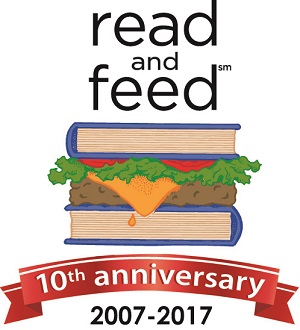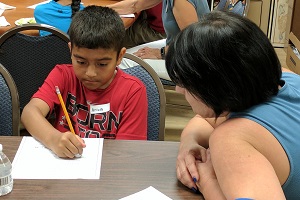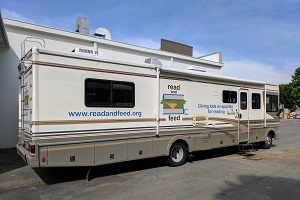By Sandy Cyr
If you ask Executive Director Kati Mullan what makes Read and Feed so successful, without hesitation she will tell you it is the volunteers. Read and Feed has over 425 active volunteers, as well as community partners who not only help ensure the programs run smoothly each week, but really invest in the children that they serve.

Read and Feed is a mobile literacy program that serves almost 600 Kindergarten and elementary school children at under-resourced public schools in Wake County, North Carolina. Their model is a hub and spoke, with a main office in the town of Cary, and program sites operating in neighborhoods throughout the county. The main office serves as a place to park the recreational vehicles retrofitted to function as mobile classrooms, to store curriculum and serve administrative functions. The programs take place in neighborhoods, either on the mobile classrooms or at facility-based partnering host sites such as churches and Communities in Schools.
Each school week from September through April and during a nine week summer session, Read and Feed holds two one-hour programs that take place between 5:00 pm to 7:15 pm. In a typical program, the first 15 minutes are spent feeding the children a family-style meal. Feeding the children eliminates the first barrier to learning; if students are hungry, they will focus on their empty stomachs and not on what they are learning. “Our model is so simple,” says Mullan. “Read and Feed. We read to the children and we feed them…It is the basics, but it works.” As part of each meal, the children get a fresh green salad and fruit. Many of the neighborhoods Read and Feed operates in are considered food deserts, where children may not otherwise have access to fresh produce. During the meals, children sit with the volunteers and talk about what they have been doing over the previous week, allowing valuable time to connect with potential mentors.
The next 35 to 40 minutes volunteers spend with the children working on reading and reading comprehension. Typically, they operate with a ratio of one student to one volunteer or two students paired by reading level to one volunteer. Read and Feed and Wake County Schools developed a Memo of Agreement to get information from the public school teachers on how to best help the individual children who are participating in the program. Liaisons in each of the partnering schools support the programs by identifying students and neighborhoods, reminding the children each week, and communicating with the parents about the program.
 The last 15 minutes of the program are spent doing what Mullan refers to as closure. Every child has a folder that contains progress notes. These notes serve as an opportunity for students and volunteers to offer feedback on the materials and the curriculum, as well as for a communication tool between the volunteers. Read and Feed asks that volunteers consider a semester-long commitment to the program to provide week-to-week consistency for the student. If a volunteer has to miss a week, the fill in volunteer can refer to the closure notes to understand exactly what they were working on in previous weeks. As part of this closure, the children also select three books to take home and keep, building their home libraries. This past year, Read and Feed gave out more than 30,000 books in Wake County.
The last 15 minutes of the program are spent doing what Mullan refers to as closure. Every child has a folder that contains progress notes. These notes serve as an opportunity for students and volunteers to offer feedback on the materials and the curriculum, as well as for a communication tool between the volunteers. Read and Feed asks that volunteers consider a semester-long commitment to the program to provide week-to-week consistency for the student. If a volunteer has to miss a week, the fill in volunteer can refer to the closure notes to understand exactly what they were working on in previous weeks. As part of this closure, the children also select three books to take home and keep, building their home libraries. This past year, Read and Feed gave out more than 30,000 books in Wake County.
While Read and Feed has a full time staff of three who handle the operations of the organization, the volunteers run the show. “We have volunteers who drive the mobile classrooms,” says Mullan. “We have volunteers who are the tutors, we have volunteers who come into the office on a weekly basis who restock the mobile classroom every day so that they are ready to go out in the evening, volunteers who help us with our library system. Volunteers pick up the food and deliver it to the program sites. Volunteers who help sort our books, volunteers who help us with the admin jobs and who serve on our committees.”
All of Read and Feed’s program sites, whether it is the mobile classroom or facility-based, have volunteers. One volunteer at each site act as a team lead, connecting the Volunteer Coordinator and the volunteers. While the Volunteer Coordinator is in constant communication with all of the volunteers, the team lead keeps up with attendance and lets the main office know if they need supplies on the mobile classrooms or at the facility-based sites.
 Community members are also vital in the success of Read and Feed. InterFaith Food Shuttle provides food to more than half of the program sites. Local business also adopt Read and Feed programs in their communities, sponsoring the sites and providing the meals for the children.
Community members are also vital in the success of Read and Feed. InterFaith Food Shuttle provides food to more than half of the program sites. Local business also adopt Read and Feed programs in their communities, sponsoring the sites and providing the meals for the children.
“It is about the community, and the community coming together,” says Mullan. “And that’s the thing that I find is that on so many different levels, we have the support of the community.” This past year, a few retirement communities wanted to get involved with Read and Feed, but did not have the time to commit to weekly reading tutors. Instead, they adopted two program sites. The residents collected food to give these families right before spring break, knowing that these children would not be in school for a week and not have access to the meals offered at school.
Every child at each site received two tote bags full of food, one full of breakfast items, and the other full of meals. “I was at one of the program site when some of the residents came out to donate these. They came to the program sites, were able to see the children, and were able to give these tote bags full of food to these families who were not expecting it, and it was so powerful. To see the appreciation and the gratitude on the faces of the families and this sense of relief, in some respects, too, to be handed these bags of food.” Because of this, the residents of these communities decided to continue to adopt sites and gather food for the children when there is a school break.
While Read and Feed provides meals and tutoring, it is so much more than a literacy program. Mullan says, “it is really more of a mentoring and nurturing. These children start referring to the tutors as ‘my tutor,’ and they look forward to seeing them every week.” These children may be learning valuable literacy skills, but the program also shows the children in need in Wake County that their community cares for them and the community cares about showing up for them every week.
Kati Mullan has been Executive Director of Read and Feed since November 2014. Kati began as a volunteer with Read and Feed in 2011 and has seen the program grow from serving 100 students to nearly 625 this coming Fall. She has a BA in Business Administration from Maryville College and a Certificate in Nonprofit Management from Duke University.
Sandy Cyr is the Managing Editor for the Philanthropy Journal, and a fan of all things related to the nonprofit sector.




